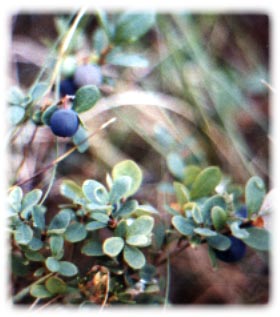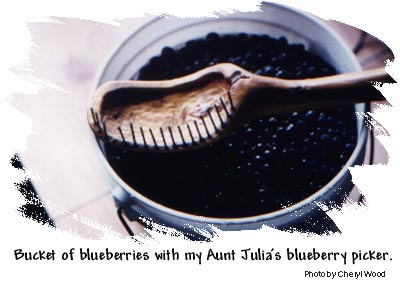Berries
Chugha

|
Iñupiaq Name: |
Chugha |
|
phonetic spelling: |
chu-gha-ha |
|
plural: |
Chughat |
|
translation / other information |
derivitave of the color blue |
|
English Name: |
Blueberry |
|
Scientific Name |
Vaccinium uliginosum |
|
Source: |
L., p. 21 |
The blueberry plant is a small shrub that grows on the open tundra around Golovnin. The bushes stand at most a foot tall or they creep along the ground just above the mosses. The highly branched bushes have dull green leaves on top and a silvery-green color on the bottom. In spring, the white to pinkish flowers are urn-shaped. Later in the summer the berries begin to develop and turn from bright green to the characteristic dark blue to purplish berry.
|
|
|
Good Grease |
|
All day we waited By the fires that night XXXXXXXXXXXXXXXXXXX Remember the marrow Good Grease. |
Chugha is a very important plant the to the people of Golovin. The Iñupiaq name, chugha, has the same root word as the color blue, chungaagtuaq . The early plants have sweet leaves that can be nibbled on for a treat, but too much grazing will damage the plant and the berries won't do well later in the summer, as Maggie Olson explained to me. In August, most everyone heads out to find their favorite berry patches, where people are spread across the tundra picking up the hills and down into the valleys. This is the time when the plants are heavy with the beautiful berries. Serious pickers will head out with 5 gallon buckets and pick for 8 hours at a time. The berry season only lasts a few weeks and the berries must be gathered at this crucial time. Whole families go picking together. Grandparents, children and grandchildren pool their days pickings and freeze them in the family freezer, usually at the grandmother's home, and distribute them over the course of the winter. I was lucky enough to go berry picking with my grandma before I left the village. We traveled across the Golovnin Bay in my Uncle Craig's boat and picked near Maggie Olson's camp. We had a great time and Grandma was very happy we went.
There are a myriad ways that the berries are used. Pies, cakes, jams, muffins, and pancakes are some of the modern ways to use the berries. However, the favorite way to eat berries is in a bowl with milk and sugar.
Traditional uses include the mixing of berries with greens such as achaaqluk into wooden barrels and stored out on the open tundra until winter time, when the barrels were retrieved. Another traditional method is the making of akutuq, or Eskimo ice cream. I was not able to see anyone make akutuq but several people told me how. The specific recipes varied greatly but I have a general idea of how to make Eskimo ice cream. The main ingredient is fat. My grandmother told me to use reindeer fat cut into small pieces. Many people these days use crisco but the preferred recipe uses animal fat. The fat is whipped until fluffy and seal oil is mixed in, as well. Once the fat mixture is whipped, a little water is added to make it more white. Then the berries are mixed in. Grandma said that blueberries; chugha, blackberries; achiet, and salmonberries; aqpik can be mixed together to add to the fat. Maggie Olson and her sister, Ruth Sellers told me that they only use salmonberries in their recipe of akutuq . Other people mix in cooked, flaked whitefish or salmon. The variations are many but the basic ingredients of berries and fat remain constant. Many Western people might turn up their noses of eating pure fat in their diets, but to the Eskimo, who live in a harsh environment and have done so for thousands of years, this diet is desirable.
